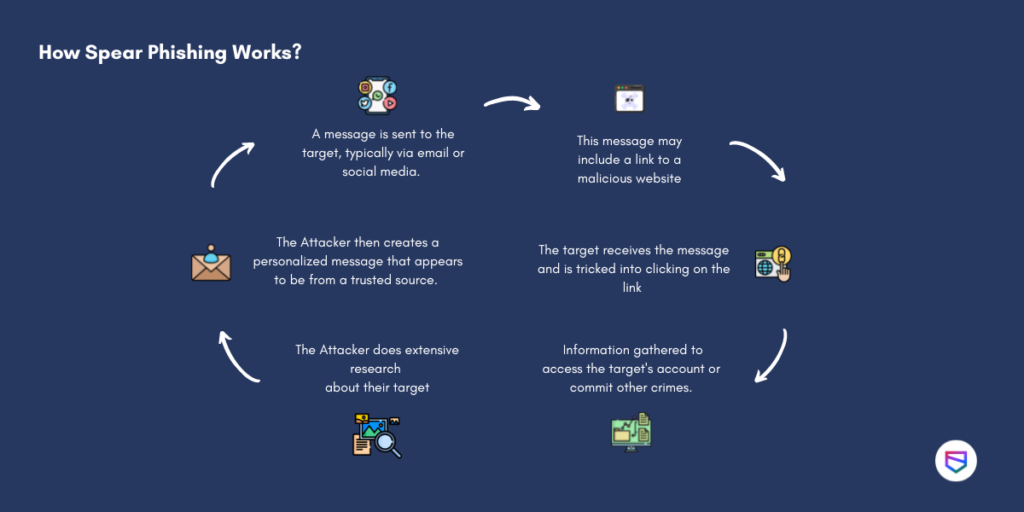
- Home
- Services
- Solutions
- Compliance
- RBI Cyber Security Framework For Banks
- SEBI Cyber Security & Cyber Resilience Framework
- UIDAI – AUA KUA Compliance Security
- RBI Guidelines for Payment Aggregators & Payment Gateways
- RBI Cyber Security Framework For Urban Cooperative Banks
- RBI Guidelines for cyber security in the NBFC Sector
- SAR Audit
- ISO27001
- PCI DSS
- GDPR
- Hipaa Audit
- SOC2 Assessment
- Resources
- Company
- Contact
Spear Phishing: A Highly Targeted Phishing Attempt
We live in a time where you have to be paranoid if you have any sensitive or valuable information. Yes, because nowadays, your web property is more likely to get hacked due to the daily cyber-attacks. There are various ways that hackers can use to access sensitive information, and spear phishing is one such method.
Have you heard about phishing or spear phishing? If not, don’t worry and continue reading this blog to know more.
Here, we’ll discuss the meaning of both and explain to you the reasons why spear phishing is considered more dangerous than phishing. Also, you’ll get to know some bonus tips to protect your website from such types of attacks.
So, let’s begin.
What is Phishing?
Phishing is a different type of cyber-attack where the attacker uses fraudulent emails or websites to steal sensitive details like login credentials, credit card details, etc., from the victims.
The attacker usually masquerades as a trustworthy entity to trick victims into sharing their confidential information.
For instance, you may receive an email that appears to be from your bank, but in reality, it is sent by a scammer who’s trying to steal your login details.
What is Spear Phishing?
Spear phishing is an advanced version of phishing that uses targeted social engineering tactics to influence victims and gain their trust.
Unlike traditional phishing attacks, which are sent to many people in the hope that someone will take the bait, spear-phishing attacks are carefully planned and targeted at a specific individual or organization.
So, if you receive an email explicitly addressed to you (rather than being generic), it could be a spear-phishing attempt.
The attacker usually has a lot of information about the victim so that they can convincingly create emails or websites that appear to be from a trusted source, such as your bank. This level of personalization makes spear-phishing emails very difficult to spot.
Spear phishing attacks are usually more sophisticated than regular phishing attacks and can be very difficult to detect.
How does Spear Phishing work?
As discussed above, spear phishing is a type of phishing attack that involves using targeted, customized messages to trick specific individuals or organizations into revealing sensitive information, such as login credentials.

Let’s understand the process in detail.
1. The attacker does extensive research about their target, including gathering information from social media and other public sources.
2. The attacker then creates a personalized message that appears to be from a trusted source. This message typically includes specific information about the target, such as their name or job title.
3. A message is sent to the target, typically via email or social media. This message may include a link to a malicious website or an attachment that contains malware.
4. The target receives the message and is tricked into clicking on the link or opening the attachment, which allows the attacker to gain access to their account or install malware on their computer.
5. The attacker then uses the information gathered to access the target’s account or commit other crimes.
Why is Spear Phishing More Dangerous Than Phishing?
Now that you know the basics of both phishing and spear-phishing let’s find out why spear phishing is more dangerous.
1. Spear Phishing Attacks are Highly Targeted
As we mentioned earlier, spear-phishing attacks are carried out after thorough research about the victim. The attacker usually has a lot of information about the victim, which they use to create personalized emails or websites.
2. Difficult to Detect
Spear-phishing attacks are highly targeted and personalized. They can be tough to detect. The attacker usually masquerades as a trustworthy entity, making it even harder to spot the difference.
For example- You may receive an email from your “bank” that looks exactly like the real thing, but in reality, it is a spear-phishing attempt.
3. Can Lead to Serious Consequences
Many organizations have suffered data breaches, financial losses, and reputational damage due to spear-phishing attacks. If the victim falls for such an attack, sensitive and confidential information like login credentials can be leaked, leading to severe consequences.
For example, in 2021 during the Russian-Ukraine Conflict, the Russian hackers targeted Ukrainian officials in a series of spear-phishing attacks to gain access to government servers for espionage purposes.
Spear Phishing Examples:
In 2021, A threat group called Golden Chickens is delivering the fileless backdoor more_eggs through a spear-phishing campaign targeting professionals on LinkedIn with fake job offers, according to researchers at eSentire.
The phishing emails try to trick a victim into clicking on a malicious .ZIP file by picking up the victim’s current job title and adding the word “position” at the end, making it appear like a legitimate offer.
Now in 2022, A new set of phishing attacks delivering the more_eggs malware has been observed striking corporate hiring managers with bogus resumes as an infection vector, a year after potential candidates looking for work on LinkedIn were lured with weaponized job offers. This year the more_eggs operation has flipped the social engineering script, targeting hiring managers with fake resumes instead of targeting job seekers with fake job offers.
The threat actors behind more_eggs use a scalable, spear-phishing approach that weaponizes expected communications, such as resumes, that match a hiring manager’s expectations or job offers, targeting hopeful candidates that match their current or past job titles.
How to Protect Your Website from Spear Phishing Attacks?
Now that you know why spear phishing is considered more dangerous than phishing let’s look at some tips that can protect your website from such attacks.
1. Use Two-Factor Authentication
One of the best ways to protect your website from spear-phishing attacks is to use two-factor authentication (2FA). 2FA is an extra security layer that verifies the user’s identity before granting access to a website or online account.
2. Educate Your Employees about Such Attacks
Another way to protect your website from spear-phishing attacks is to educate your employees about such attacks. Teach them how to spot suspicious emails, who to report them to, and how to prevent falling for such attacks.
3. Keep Your Website Secure
You should also keep your website, and online accounts secure by implementing the latest security measures and protocols. It will significantly reduce your risk of being the target of a spear-phishing attack.
4. Use a VPN
Consider using a VPN whenever you access the internet, especially if you are using public Wi-Fi. A VPN encrypts your web traffic and hides your IP address, making it difficult for attackers to target you with spear-phishing attacks.
5. Install an Antivirus Software
Another way to protect your website from spear-phishing attacks is to install antivirus software. Antivirus software can detect and block malware, including those used in spear-phishing attacks.
6. Use a Password Manager
A password manager is an advanced software that helps you generate and manage strong passwords for your online accounts. It is good to use a password manager to create unique and complex passwords for all your online accounts. This way, even if one of your accounts is compromised, the attacker will not be able to access your other accounts.
7. Keep Your Software Up-to-Date
The next best way to protect your website from spear-phishing attacks is to keep your software up-to-date. Attackers often exploit security vulnerabilities in outdated software to access targeted websites or accounts. Therefore, it is vital to update your software and other security measures regularly.
8. Be Vigilant and Alert
Finally, it is also critical to be vigilant and alert while browsing the web or accessing online accounts. You should always stay on top of the latest news about cybersecurity threats and avoid any suspicious emails or links. With this, you can significantly reduce your risk of falling into a spear-phishing attack.
Conclusion
Overall, spear-phishing is a dangerous and increasingly common cyber threat that can have severe consequences for organizations. They pose a significant risk to businesses due to the confidential information they can access.
But the proper security measures, such as two-factor authentication, educating employees about such attacks, and keeping your site secure with the latest security protocols, can help protect your website from phishing attacks.
It is also vital to be vigilant when browsing online to avoid falling for scams or malicious attacks. With these bonus tips in mind, you can take steps to protect your website and business from spear-phishing attacks.
Want to learn more? Find out how WeSecureApp can help prevent and defend against spear-phishing attacks – and protect your data from being compromised or stolen.








